We all know the state of the
running back position in the NFL. The past ten years have brutally stripped it
of any value, to the point at which there have only been two running backs
selected in the first round in the past three seasons (Todd Gurley and Melvin
Gordon last year). There will probably be one more added this year, but for the
most part teams believe this is a position that is
better addressed later in the draft.
That doesn’t mean that the
running back position is irrelevant, and that doesn’t mean we should ignore it
heading into the draft. Running backs have fallen out of favor, but they can
still play a huge role in an offense, and the ability to find a good one in the
second or third round only sweetens the deal.
The role of the running back has
changed, and with this so have the requirements to play it. Scouts still look for
physical and fast runners who can break tackles and outrun defenders, but those skills now need to be supplemented by others. Running backs
need better vision, need the ability to catch the ball out of the backfield,
and need to know how to protect the quarterback. The era of the 20 carry a game
bellcow may be behind us, but a new type of running back is on the rise, with
the potential to rebuild the value of the position for the modern NFL.
Ezekiel Elliot, Ohio State

No position in this draft is as
clearly dominated by one player as running back. Ezekiel Elliot is the best
running back in the class, and it isn’t particularly close. It almost feels
strange to construct this list as I have, with other players sitting just
beneath him as if there is some argument to be made between first and second.
In a lot of ways, Elliot is in a different position class altogether from the
other running backs, and he almost deserves a post of his own.
Elliot’s running style is defined
by its versatility. He boasts power, speed, and agility, and he uses them all
with intelligence and instinct to carve his way through a defense. He bursts
off his initial step and with each cut he takes, and once he hits the second
level he is able to outrun everyone on the defense to the endzone. Tacklers
slide off of him like he’s coated in grease, and he is quick enough that he
never takes a hit square, always sliding to the side and finding a way to fall
forward even if the tackler latches on.
There are two main criticisms
that can be made of Elliot as a runner. The first is that he sometimes dances
too much in the backfield, a common issue that experience and coaching can
cure. The second is a bit more esoteric. While he does a lot of things well,
there is nothing about his running style that is overwhelming or elite. He
doesn’t have the power of Marshawn Lynch or the quickness of LeSean McCoy or
the patience of Le’Veon Bell. He has a good combination of all of these traits,
but there is nothing about him as a runner that screams of unmatched talent.
When discussing Elliot, he can’t
be compared to the other running backs in the class. There’s no argument to be
made there, and it isn’t worth the time. Instead we should focus on how he
compares to other top running back prospects to figure out where he belongs in
the draft. The easiest comparison is Todd Gurley, the only running back
selected in the top ten in the past three drafts. And as a runner, there is no
question that Gurley was a better prospect. Injury concerns dropped him lower
than he probably should have gone, but his skills were still well beyond
Elliot’s in the running game.
The running back position is
interesting in the draft because of how much the value of the position has
changed. In 2005—just eleven years ago—three of the first five players selected
were running backs. But as the league has become more passing oriented, the
position has lost almost all of its value. It now requires a rare talent—a Todd
Gurley level talent—to make it into the top ten, a level of talent Elliot
doesn’t possess.
But this is where things get
interesting with Elliot. Because while he doesn’t stack up as a runner, the
skills that are more valuable for the modern game are the skills that make him
an elite prospect. Elliot is an excellent receiver out of the backfield, and he
is quite possibly the best pass blocking running back I have ever seen. The
team that gets Elliot will be getting a complete player, someone who can step
on the field and contribute from day one. He is a very good runner, but if it
was only for that, I’m not sure he’d be worth much more than the twentieth
pick. Factor in his other abilities however, and you have the rare running back
worthy of going in the top ten.
Paul Perkins, UCLA
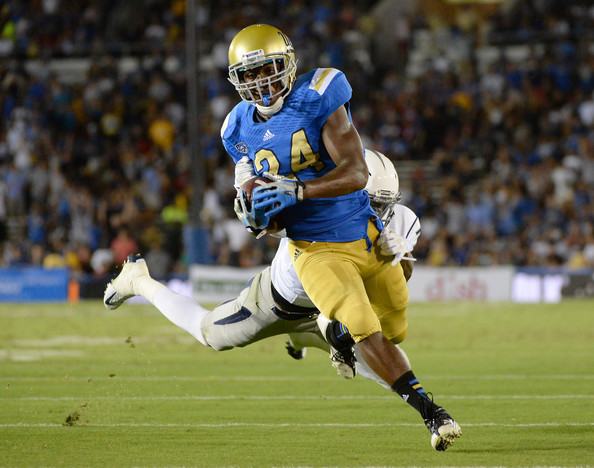
If you don’t get Elliot in the
first round, you’re going to have to wait until the second to find a running
back. Fortunately, there are three quality backs worthy of a selection in that
round. And of those three, Perkins is the best and most complete option, a back
who combines power and quickness in a way that will make him an asset in any
system in the league.
When looking at Perkins, it isn’t
hard to see why he is less well thought of than Elliot (and why many
projections have him ranked lower than I do). He is undersized at 5-10 and 208
pounds, and he isn’t particularly fast, running only 4.54 in the forty yard
dash. He is not on Elliot’s level as an athlete, and he is probably below each
of the next two backs on this list. But he plays larger and faster than he
actually is, and he combines that with good instincts to be an effective
runner.
I was actually surprised when I
looked up the numbers and saw how small Perkins is, after watching him on tape
break tackle after tackle. He plays with excellent balance, and tacklers
regularly slide off his legs while he keeps churning ahead. He makes extremely
sharp cuts in the open field, and it is difficult to get a square hit on him.
At times he can leave defenders looking absolutely helpless as he turns what
should be a sure tackle into a big play.
The speed is a concern, but it
isn’t as big a deal as you’d initially think. When it comes to playing football there are really two types of
speed. There is “long speed”, which is the ability to burst at the second level
and run away from defenders, and there is “short speed”, the ability to ramp up
to the highest level in just a few short steps. Perkins definitely lacks long
speed, but his short speed is more than satisfactory. He can outrun defenders
to the edge, and he can mess with tackling angles as he cuts through traffic.
No, he won’t be breaking any sixty yard runs, but he can churn out ten to
twenty yards with ease.
After Elliot I see Perkins as the
most sure thing at running back in this draft. He has a polished game,
displaying good vision and excellent patience in allowing his blocks to get set
up in front of him. He wasn’t used much in the passing game at UCLA, but based
on the limited activity I saw and his innate physical abilities, I think he
could develop into a reliable option as both a receiver and a pass protector.
Alex Collins, Arkansas
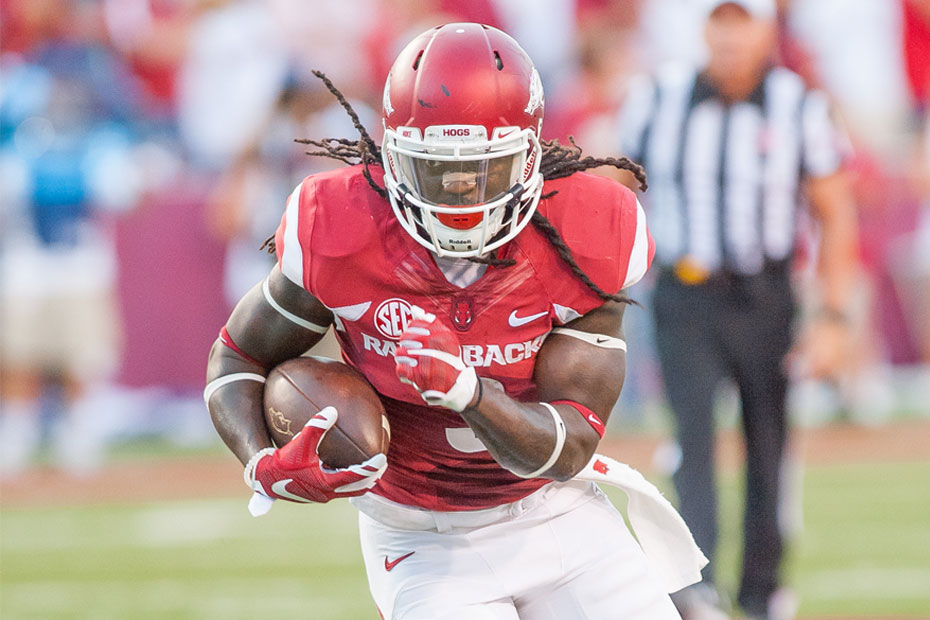
Collins is another example of the
difference between long and short speed, just in the opposite direction from
Perkins. While he isn’t as extreme as some cases (see Derrick Henry a couple
ranks lower on this list), he is much more impressive once he can get his
momentum built up and break through the second level of the defense. He is an
explosive runner who struggles at times to get through the initial level of the
defense, the sort of player that will alternate moments of brilliance with
extended periods of frustration.
Collins’s speed isn’t world
breaking, but he has more than enough to run away from chasing defenders. He
does a good job making the most of the speed he has, using subtle bends down
the field to mess with pursuit angles. He can make a slight
change of direction without losing speed, allowing him to escape safeties and
pursuing linebackers and turn a good play into a great one.
The troubles he runs into are at
the immediate level of the defense. He doesn’t move particularly well from side
to side, and defenders in front of him usually end up bringing him down. He
shows good vision and patience at times, but he still will sometimes try to
dance too much, slowing him down and giving him even less hope of breaking
through tackles. He doesn’t possess spectacular strength, and even though he
can fall forward, he isn’t going to fight through contact to extend a run.
Collins benefited in college from
a behemoth offensive line that was constructed solely with the purpose of
opening holes in the running game. They carved a lot of space between the
tackles, and he did a good job utilizing this space, even if it wasn’t a
particularly difficult task. On the rare occasion there was nothing there for
him, he was vulnerable to negative plays, a flaw that will be exposed in the
NFL. Wherever he goes, he’s fated for a bit of a boom or bust career, and while
enough boom could get him to play at a Pro Bowl level, I think a solid starter
is the best that can be hoped for.
Kenneth Dixon, Louisiana Tech
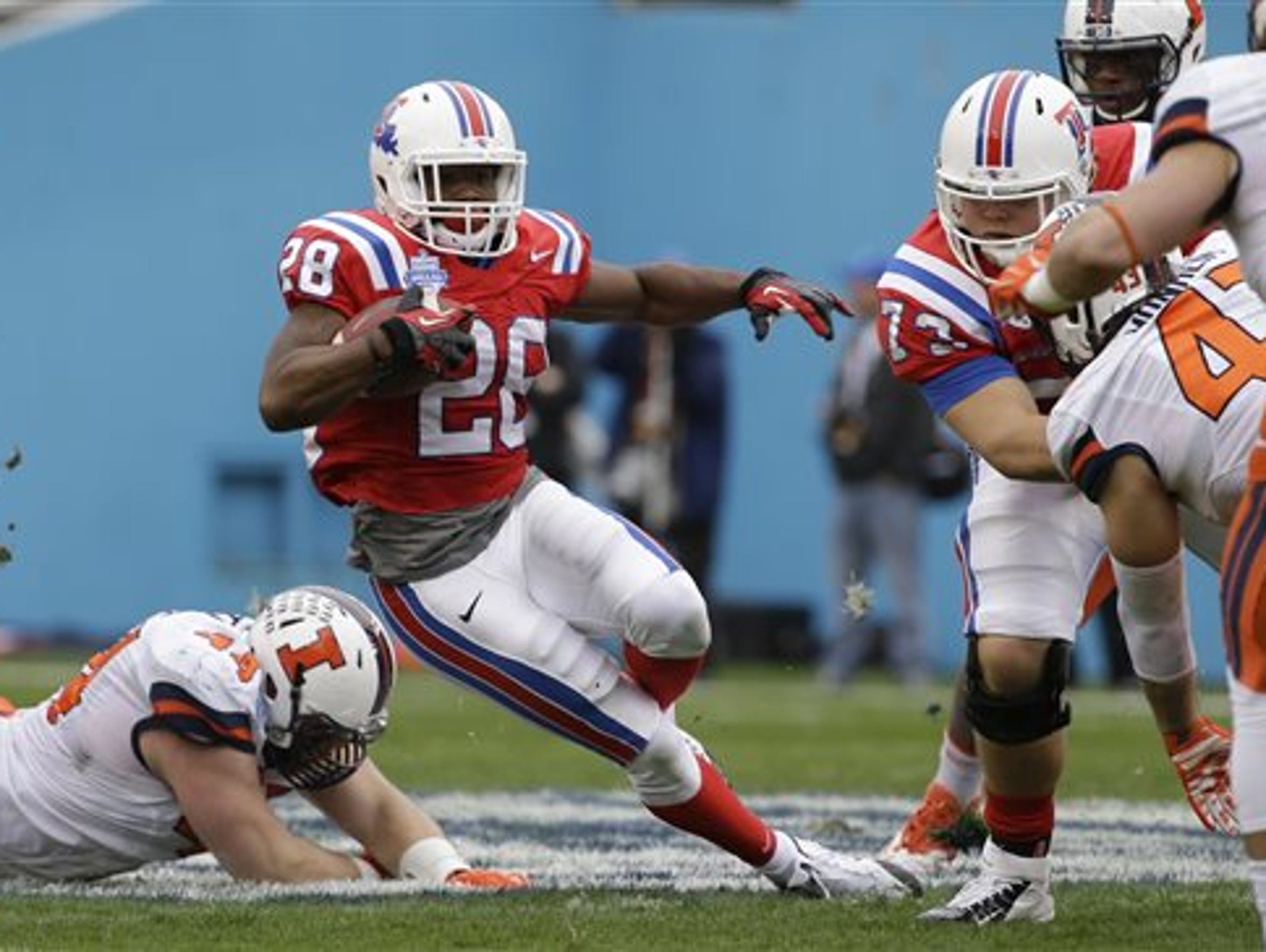
The separation between number two
and number four on this list is not that great, and depending on what you want
from a running back, there could be a strong case made for Dixon as the second
to go off the board. He doesn’t have the tackle breaking ability of either
Perkins or Collins, but he makes up for it with elite elusiveness in the open
field.
Watching Dixon run just looks different from all the other running
backs on this list. His cuts are so much sharper, and his first step is so much
quicker. He can dance circles through defenses while still gaining ground,
almost seeming to hop as much as run as he maneuvers through traffic. His
vision is phenomenal, and his burst just messes with the minds of the defenders
trying to catch him.
Like all young running backs with
his skillset, Dixon can dance himself into trouble. But he can dance himself
out of trouble just as easily, making defenders miss both between the tackles
and on the edges. He is already a good receiver, and he has the skills to
become even better, the sort of weapon that a smart offensive coordinator will
scheme into matchups the defense cannot hope to win.
Dixon can be great, and he has a
higher ceiling than either of the two I listed above him. But as good as he is
at making people miss, I can’t get over just how much his game relies on this.
Dixon fights hard through contact, but there is only so much he can do with his
physical ability. A player like Perkins can’t move in the same way Dixon does,
but his ability to slide through arm tackles gives him much greater margin for error than a player like Dixon, who can be brought down with a single hand.
Dixon can do awe inspiring things in the open field, but I get nervous about a
runner who is so limited in his skillset, and I would hesitate to grab him
until the latter portion of the second round.
Devontae Booker, Utah

For a team looking for immediate
impact at the running back position, their best bet might be to grab Booker in
the third or fourth round. Though his upside doesn’t match that of the players
listed above, he has all the skills needed to contribute in the NFL right away.
From day one he can find a role as a third down back, with the potential to
grow into more as his career goes along, even if he’ll never be a top tier
running back.
Physically Booker is nothing
special. He doesn’t have breakaway speed, and he isn’t particularly powerful.
He can break an occasional tackle, but for the most part he goes down as soon
as someone can get a hand on him. He does do a good job of falling forward by
sliding away from contact, and he’s good enough at finding holes that he could
potentially contribute as a short yardage option.
Booker’s greatest asset is his
ability to play through traffic. He isn’t going to break ankles in the open
field, but he has good small area quickness, working with solid vision to give
him the ability to cut through small gaps in the defense. This won’t turn a
three yard run into a sixty yard run, but it can get him seven or eight.
Booker is a solid back with skill
to make up for rather bland physical ability. He catches the ball well out of
the backfield, and he is strong in pass protection. It would be nice if he
didn’t dance so much in the backfield, but this won’t be a major hindrance if a
team wants to slide him immediately into a role as a third down back.
Derrick Henry, Alabama
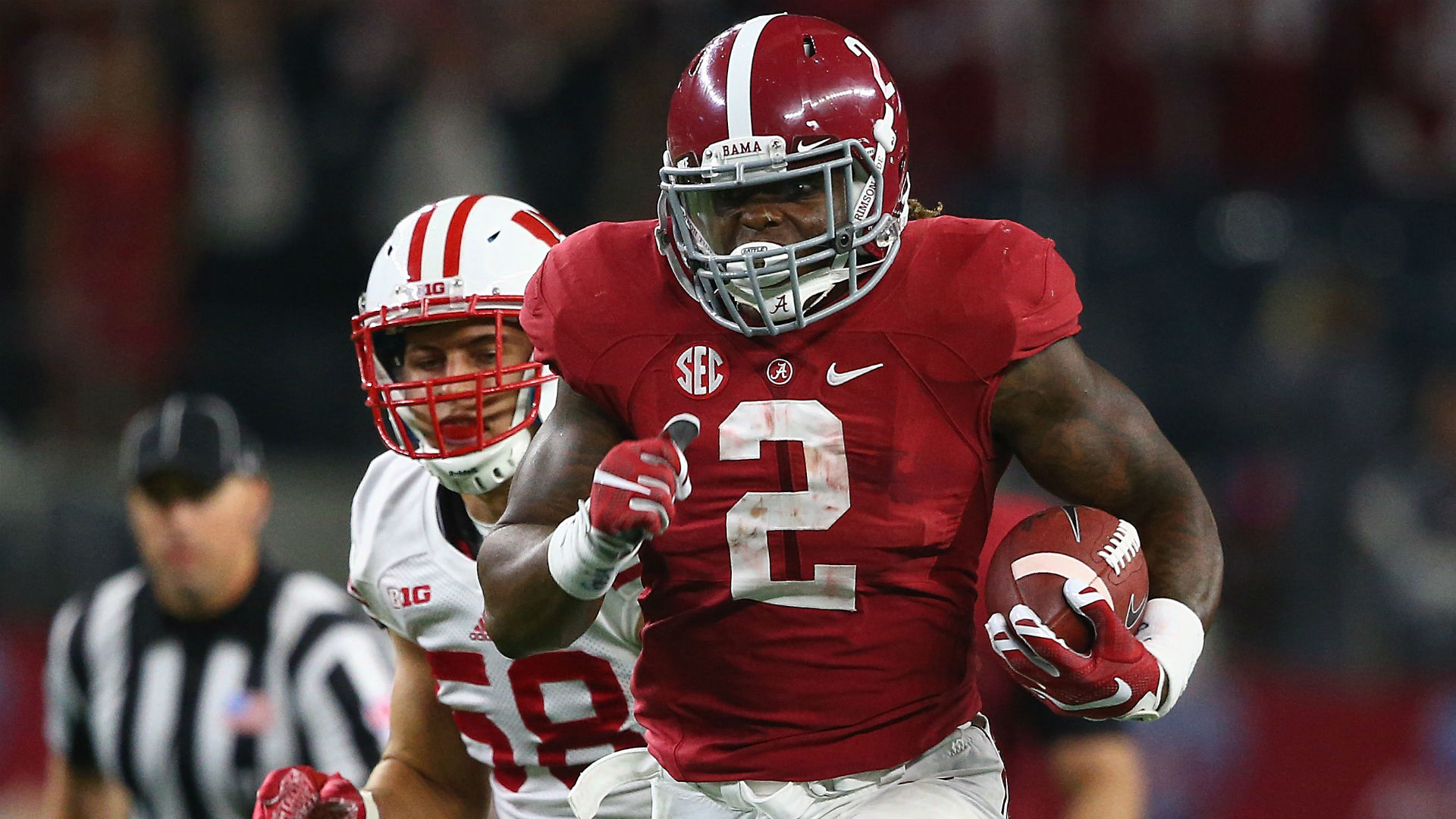
When Henry gets rolling, he
cannot be stopped. This is what won him a Heisman Trophy, and this is what
makes him intriguing as an NFL prospect. With huge stature and great long
speed, he is a safety’s worst nightmare charging down the middle of the field.
No player in this draft is better at breaking off an explosive run. It’s just a
shame that this is Henry’s only skill.
Henry can be unstoppable when he
gets going downfield, but outside of that he is very easily shut down. His
biggest problems present themselves when he tries to change direction. He is
incapable of sharp cuts, and he usually has to take two or three steps whenever
he wants to go somewhere else. At times his feet come to a total stop, making
it even harder for him to get back up to full speed.
And once his feet come to a stop,
the less obvious of Henry’s flaws presents itself. For someone who is 6-3 and
247 pounds, he is remarkably easy to bring down. He doesn’t have great leg
drive at the point of contact, and he takes every hit square on his chest.
Occasionally defenders will get scared and go for his legs, allowing him to
fall forward, but most of the time he is hit within five yards of the line of scrimmage,
he does not go any farther than that.
Henry can’t make defenders miss,
and he won’t break a lot of tackles around the line of scrimmage. He offers
next to nothing as a receiver, and he is somehow just as boom or bust as a pass
blockers as he is as a rusher, alternating powerful blitz pickups with
excruciating failures. There is a place for a runner with Henry’s skills in the
NFL, but that place is so narrowly defined. If his line and his coaches can get
him to the second level consistently, he can be a very successful runner. If
they can’t, he could be out of the league in four years.
Jordan Howard, Indiana
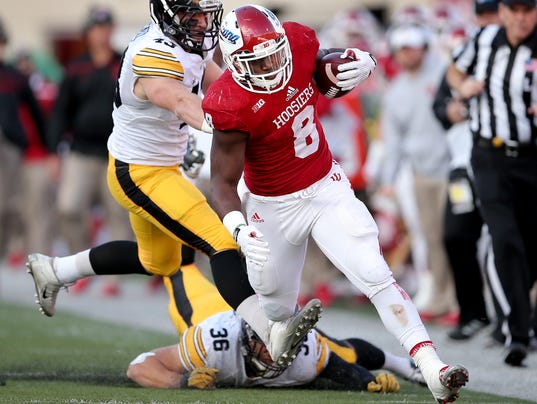
Howard is probably the least
complicated runner in the draft. He takes the ball, he runs to the hole, and
then he keeps running in that direction until someone gets in his way. He
doesn’t change directions, he doesn’t make cuts, and he doesn’t run away from
defenders. In a lot of ways he is a similar runner to Henry, just with slightly
more power and a lot less speed.
Howard is most successful when
he’s attacking downhill through a very clearly defined hole. He doesn’t get
stopped for a loss very often, and he doesn’t break off more than ten yards
very often either. He does a good job fighting through contact, but he doesn’t
really slide out of tackles, just drags defenders for a couple extra yards
before falling down. Unlike Henry though, he does this at every level of the
field, including at the line of scrimmage and in the backfield. His power comes
from leg drive rather than momentum, making him a more reliable option in short
yardage situations.
The best role for Howard in the
NFL will probably be as a backup and occasional short yardage specialist. If
needed he can carry the load, but he’ll never be the sort of runner that will
leave a team comfortable with the position. There is very little upside here,
and I definitely wouldn’t take him before the fourth round, and probably not
before the fifth.
No comments:
Post a Comment